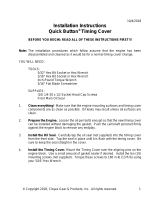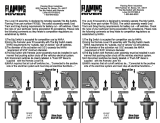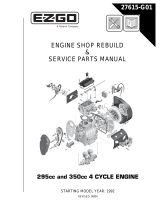Page is loading ...

COMP Cams®
3406 Democrat Rd.
Memphis, TN 38118
Phone: (901) 795-2400 Fax: (901) 366-1807
www.compcams.com
Part #188
Revised 3/14/08
Hi-Tech™ Belt Drive Systems
Small Block Chevrolet #6500, 6502, 6504, 6506 & 6507
Big Block Chevrolet #6200 and 6300
Thank you for choosing COMP Cams® products; we are proud to be your manufacturer of choice. Please read
this instruction sheet carefully before beginning installation, and also take a moment to review the included
limited warranty information.
COMP Cams® belt drives represent the ultimate in cam timing systems. Our belt drives are designed to absorb a
significant amount of crankshaft harmonics, which will affect valve motion if they reach the valve train. COMP
Cams® belt drives require less power to operate than conventional belt drives. Last but not least, our belt drives
have proven to be more durable than either gear or chain drives.
Excellent for all NASCAR and NHRA applications
Unique camshaft thrust adjustment system does not require the use of shims to set end play
Belt idler reduces belt “flap”
High performance belt
Idlers available in different diameters for align bored blocks
Adjustable camshaft timing with simple Vernier sprocket
Double lip oil seals ensure maximum crankcase vacuum
Installation Instructions:
NOTE: The COMP Cams® Chevrolet belt drive system can be installed on an assembled engine.
However, the installing mechanic should be prepared to remove the camshaft for the purpose of
drive hub installation and end play adjustment.
INSTRUCTIONS

COMP Cams®
3406 Democrat Rd.
Memphis, TN 38118
Phone: (901) 795-2400 Fax: (901) 366-1807
www.compcams.com
Part #188
Revised 3/14/08
Step 1: Disassemble the unit. It comes from the factory with several components assembled for protection during
shipping. Unbolt the camshaft pulley from the drive flange and separate the flange from the cam hub. This is done
by removing three 5/16 cap screw head bolts and using a drift punch or driver to separate the flange and hub (fig.
1). Remove the belt tensioner from the rear belt cover. Also, remove the camshaft endplay adjustment housing
(three Allen bolts)
Step 2: Trial fit front cover to make sure it clears the block. Much detail has been
given to fitment and most covers will not require modification. If required, use a die
grinder or mill to remove excess material from cover and/or block. Take steps to
prevent removed material from contaminating engine.
Step 3: Install front cover on engine using supplied gaskets and fasteners. Torque the
front cover bolts to 7-10 ft lbs of torque.
Step 4: Install crank pulley on crankshaft snout. Lubricate
the bore and seal area of the crank pulley with COMP
Cams® pro cam lube, part # 152. Use COMP® part #4789 crank gear installation tool and
#4920 harmonic balancer installation tool to press pulley onto snout or a section of 2-1/4"
o.d. x .375" wall aluminum tubing (fig. 2) as a driver. Caution: Be certain that the
crankshaft snout is not marred and that the crank hub seats squarely on the crank’s
shoulder step.
Step 5: Ensure that the front face of the camshaft is clean and free of surface burrs.
Any minor imperfections may be removed with a fine grit knife sharpening stone.
Install cam hub on camshaft (you may need to tap into place using a plastic mallet,
etc.). If needed, brace the camshaft by its bearing journals in a vise, being sure to pad
the jaws with wood or plastic to prevent damage to the camshaft. Use supplied 5/16" x
1" cap screws to secure hub. Add a small amount of medium strength thread locking
adhesive and tighten bolts to 18-22 ft lbs of torque (fig. 3).
Step 6: Lubricate roller thrust bearing with engine oil and install on backside of cam
hub. You can slide the bearing over the camshaft. Be sure that black-colored side of the
thrust bearing seats on the cam hub (fig. 4).
Step 7: Install camshaft in engine and place other roller thrust bearing on front side of
the hub (with black surface of bearing contacting the hub).
Step 8: Make sure cam hub and bearings are seated squarely on face of the engine block.
Any irregularities may cause a premature bearing and/or hub failure.
Step 9: Remove o-ring from camshaft end play
adjustment housing, install housing on the cam hub and
make sure seal is properly seated. Rotate housing
clockwise until it bottoms out on ramp. Gradually rotate
housing counterclockwise until desired camshaft
endplay is achieved. An endplay range of .002" to .007"
is suggested. However, this is ultimately left to the
discretion of the installing mechanic (fig. 5). The
assembly is designed so that each adjustment point
during rotation (where bolt holes line up) is equal to
.005". Once the desired endplay has been achieved, mark the housing and front cover at the appropriate bolt hole
with a felt tip pen as an indicator for reassembly (fig. 6). A scribe may also be used to mark the housing and front

COMP Cams®
3406 Democrat Rd.
Memphis, TN 38118
Phone: (901) 795-2400 Fax: (901) 366-1807
www.compcams.com
Part #188
Revised 3/14/08
cover, but the permanent mark made by a scribe may complicate future installations. NOTE: On some
aftermarket blocks and refaced OEM blocks, it may be necessary to alter the position of the timing cover
by adding or subtracting front cover gaskets.
Step 10: Replace o-ring on backside of endplay adjustment housing and attach housing to front cover using the
three supplied 1/4-20 x 1/2" button head cap screws. Place a small drop of low strength thread locking compound
on the cap screws and torque them to 10-12 lbs/ft.
Step 11: Install cam drive flange onto cam hub. Rotate flange 180 degrees if required
to align three holes in flange with threaded holes in hub. Use supplied 5/16-24 x 7/8"
Torx™ head cap screws. Make sure bolts don’t bottom out. Apply a drop of low
strength thread locking compound and torque bolts to 18-20 lbs/ft (fig. 7). Use
screwdriver to hold flange.
Step 12: Rotate crankshaft so that the alignment mark on crankshaft pulley is straight
up (12:00 position) and turn camshaft until "0" mark on drive flange is pointed straight
down (6:00 position).
Step 13: Place belt in position with teeth engaged on bottom pulley and upper portion
laying flat against cover (fig. 8).
Step 14: Position red cam pulley over drive flange with degree
markings on bottom (at 6:00 position). Wiggle pulley (if
required) and push over studs (fig. 9). Install the supplied
stainless steel washers and 5/16-24 flange nuts finger tight.
Step 15: Rotate engine a minimum of two revolutions to get
belt properly seated and on centerline (fig. 10).
Step 16: Install belt tensioner pulley on mounting stud with
snap ring toward cover (fig. 11). You may have to push the
belt and wiggle the pulley to get it started. Attach pulley with
supplied 3/8-24 12-pt nut. Apply a drop of low strength thread
sealer and torque nut to 25-30 lbs/ft (fig. 12).
Step 17: The cam is now ready to be degreed per your
requirements. If the engine is in the short block stage, you can
set the No. 1 piston to Top Dead Center, and degree the
camshaft as you would with any other timing set. Note that
some engine builders prefer to advance cam an additional 1 to
1-1/2 degrees in order to compensate for belt stretch. When
the degreeing process is performed on a long block, there is
generally enough tension on the valve train to facilitate a
direct setting.
Note: The pulley is designed to provide up to 10 degrees of advance or retard. Should more than 10 degrees
be required to properly phase the cam, you must move the belt one tooth on the bottom (crank pulley) to
bring belt drive system into the next window of adjustment.
Step 18: When camshaft is degreed as desired, torque the cam pulley nuts to 18-22 lbs/ft of torque using low
strength thread locking compound.
Fig. 11

COMP Cams®
3406 Democrat Rd.
Memphis, TN 38118
Phone: (901) 795-2400 Fax: (901) 366-1807
www.compcams.com
Part #188
Revised 3/14/08
Additional installation notes:
1. Included only in the small block kit is a 2” diameter washer and left hand thread, 7/16”, 12 pt bolt (torque to
30 ft lbs) for use with a MSD, etc. cam driven distributor. This must be installed on the drive to prevent any leaks.
2. Included only in the big block kit is an oversized belt tensioner pulley (black anodized) that can be used on
those applications where the cam-to-crank centerline distance has been reduced due to line boring the engine
block, or the belt has become stretched. Simply remove the belt tensioner bearing and assembly from the red
anodized unit, install it in the black housing, and use the black anodized idler pulley in place of the red one (fig.
11).
3. Also included only in the big block kit is a pair of water pump spacers and gaskets that must be used to
position an OEM pump for proper clearance.
4. A pilot tool included only in the big block kit, designed to facilitate installation
of the cam pulley/flange assembly, is supplied for use in dynamometer
environments, where numerous cam changes are desired (fig. 13).
5. The unit is designed for use in a paved, on-road environment. Make sure that
rocks and debris are prevented from getting into the assembly. Keep clean of dirt
and oil. It is possible to use this drive in a dirt track application, provided that a
cover is fabricated to isolate the drive from contamination by dirt and debris.
Limited Warranty
Competition Cams, Inc. warrants that all of its products are free from defects in material and workmanship, and against
excessive wear for a period of (1) one year from the date of purchase. This limited warranty shall cover the original
purchaser.
Competition Cams, Inc.’s obligation under this warranty is limited to the repair or replacement of its product. To
make a warranty claim, the part must be returned within (1) one year of purchase to the address listed below, freight prepaid.
Items covered under warranty will be returned to you freight collect.
It is the responsibility of the installer to ensure that all of the components are correct before installation. We assume
no liability for any errors made in tolerances, component selection, or installation.
There is absolutely no warranty on the following:
A) Any parts used in racing applications;
B) Any product that has been physically altered, improperly installed or maintained;
C) Any product used in improper applications, abused, or not used in conjunction with the proper parts.
There are no implied warranties of merchantability or fitness for a particular purpose. There are no warranties, which
extend beyond the description of the face hereof. Competition Cams, Inc. will not be responsible for incidental and
consequential damages, property damage or personal injury damages to the extent permitted by law. Where required by law,
implied warranties or merchantability and fitness are limited for a term of (1) one year from the date of original purchase.
This warranty gives you specific legal rights and you may also have other legal rights, which vary from state to state.
/


